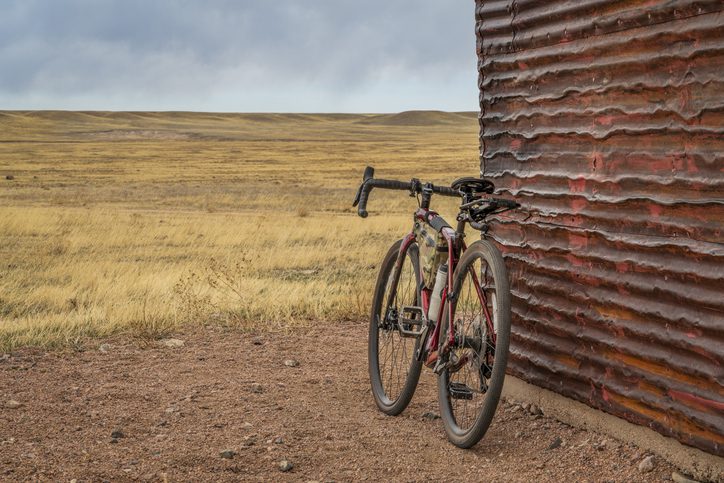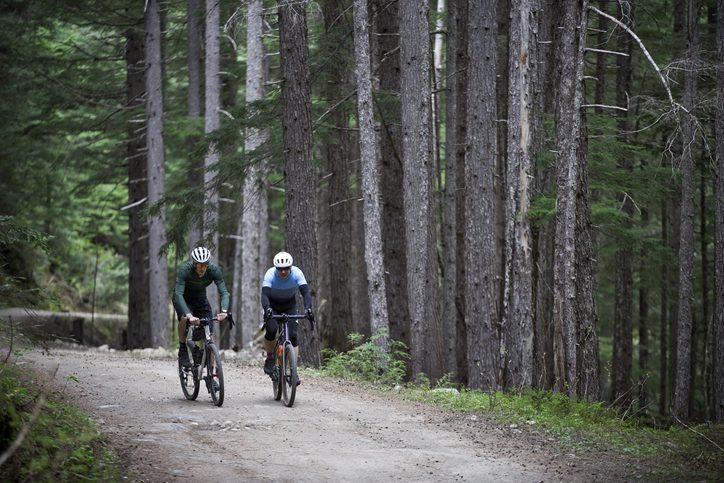Should Your Next Bike Be a Gravel Bike?
The number of bikes a triathlete "needs" is N+1, right? Maybe not - can you convert your bike for gravel?
 Photo by:
Getty Images
Photo by:
Getty Images
It doesn’t take much to convince triathletes that they need a new bike. But if you’re looking to get into gravel, it’s possible that your gravel bike could be the least expensive in your herd. In fact, you might already own a bike that can double as your gravel ride.
Unlike road bikes, which really can only work for you on pavement or (in a pinch) packed dirt roads, a gravel bike can roll on rough terrain as well as smooth roads (though it will be slower on pavement than a pure road bike). In fact, most gravel races and popular local routes are going to include some paved roads, if only to make the connection from one gravel road to another.
To the naked eye, road bikes and gravel bikes look very similar. Both have drop handlebars. Neither have mountain-bike-style suspension. But, look closer, and there are important differences. Gravel bikes have a longer wheelbase and a more upright riding position for better stability and more comfort on rough, uneven and moving surfaces.
The handlebars are also wider for better stability and control; some even flare out to the sides for better wrist clearance when you’re descending (yes – you descend while in the drops).
Gravel bikes usually come with more attachment points for storage accessories like top-tube bags, panniers and even bags that can attach to your fork. These are handy if you’d like to someday try bikepacking, where you need to carry all your camping gear for multi-day treks.

1x gearing – with a single front chainring – is also a hallmark of gravel bikes (though you can find some compact (double) chainrings on gravel bikes too). A single chainring means you don’t need a front derailleur, so there’s much less chance of a dropped chain (a far more common occurrence on rough terrain), less weight and fewer mechanical doodads to get caked with mud. Coordinating with the single front chainring is also a wider cassette range in the back. Where a typical 11×28 road bike cassette has a 28-cog ring for its biggest (easiest) gear, a gravel bike comes with more range, with maybe an 11×36 cassette in the rear.
Lastly, a gravel bike has another bonus in store: You can use it as a cross bike and try your hand at an XC event (a topic for another article in this magazine).
As with road and triathlon bikes, carbon and aluminum are the most common frame material, but you can opt less expensive aluminum. Aluminum is great at absorbing road vibration and is plenty durable; it’s heavier than carbon, but unless you’re racing regularly for a podium spot, aluminum will save you a lot of money over carbon. As far as brands, the bike companies all offer gravel bikes, and brands that specialize in mountain bikes usually offer gravel bikes too, so you’ll recognize the names.

Tire clearance is everything
Most road bikes, especially pre-2018 (or so) road bikes, can handle tires no wider than 25mm. Skinny tires can work on tightly packed (and dry) dirt roads, but toss in any kind of rock, pothole, mud, or sand, and their limitations will quickly become apparent: You’re going down. Those tiny tires just don’t contact the surface enough and are practically impossible to control on loose terrain. A good “all around” gravel tire size is 38 or 40 mm; most road bikes aren’t going to be able to handle a wheelset that wide, but some frames can come close.
Check your front fork and your rear chain stays. If you can fit a finger between your tire and your frame, you can hit the bike shop and try a wider rim and tire set. Other considerations include the type of brakes you have and your overall bike geometry, but your local shop can weigh your options.
If that won’t work, here’s what to look for in your first gravel bike, whether buying new or used.
Related: Why are triathletes flocking to gravel riding – and should you join them?
You want disc brakes
The entire cycling industry is moving to disc brakes, anyway, but they’re especially ideal for gravel. Rocks and mud can easily glom up caliper brakes, which can cause slippage. Disc brakes are much better in the muck and are much more responsive and efficient. Disc brakes have taken over to such a degree that this probably won’t even be a choice you’ll need to make.
The other bonus of disc brakes compared to calipers is tire clearance. You can go all the way up to 50 mm on many (if not most) gravel bikes, so you’ll have future flexibility to go even bigger and tackle the roughest, wettest, gnarliest terrain.
It’s tubeless time
You’re going to be a lot happier in the long run if you’re using tubeless tires on gravel. A tubeless tire forms an airtight seal with your rim, then is filled with a sticky gel-like sealant. With no innertube, there’s zero chance of the dreaded pinch flat. Punctures are quickly filled and repairs with the sealant inside the tire. You can also run much lower tire pressure on wide tubeless tires. Where you might pump your road bike tires to 80 or 90 psi, your tubeless gravel-bike tires can run in the mid-30s. The result? A comfortable ride that absorbs tons of vibration, while also allowing for maximum contact with the road or track surface.

SPD pedals and shoes
Nothing fancy! Typical road pedals and cleats get caked with mud and dirt, and it’s harder to clip in. Inexpensive SPD pedals are the way to go. Unlike road bike pedals, SPD, or mountain bike pedals, are double sided, making it easier to clip in and out. You’ll need shoes that take a two-bolt cleat, but leather mountain bike shoes can be a lot less expensive than carbon road-bike shoes.
Related: Angela Naeth on the joys of gravel riding
Essential accessories
First, there are some items you won’t need for your gravel bike, like a power meter. Unless you are the wonkiest of gearheads, gravel riding is more about efficiency, picking your line, and navigating changing road surfaces as best you can. So, skip the $600 power meter.
You also can skip fancy bottle cages. You won’t believe how quickly a water bottle can become caked with dirt and mud on a gravel ride. Delicious. It’s also tough to ride one-handed long enough to grab and replace a water bottle when you’re riding on rough terrain. Instead, most gravel junkies ride with a hydration vest and flexible straw for clean, hands-free sipping.
You will want a solid GPS-capable bike computer if you don’t have one already. Many backroads are minimally marked, if at all, and there won’t be gas stations or people around to point you in the right direction. Many gravel riders pre-load routes on their GPS and use turn-by-turn navigation. In fact, nearly all gravel races expect athletes to download the course and navigate – there are no course marshals. It’s simply inevitable that someday, you’re going to get lost on a gravel ride. Your GPS bike computer can get you back on the right track.
Lastly, buy yourself some good shock-absorbing gloves. The bumps and rattles on gravel are constant, and a good pair of gloves can be the difference between a fun day in the saddle and miserable, red, chafed hands.
Now, go forth and gravel!
